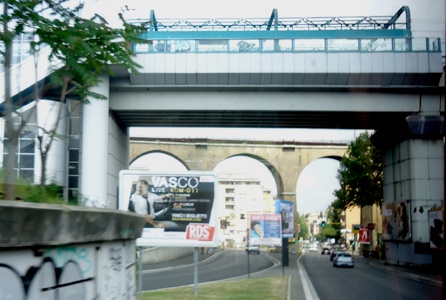Rome Diary - Part II
14 April

You realise how significant this complex was when you stand next to a pillar fragment that is almost as wide as you are tall. The remaining footprint on the podium that once supported a statue of Augustus indicates he would have stood almost 14 meters tall!
During the lunch break, I hiked east past the Colosseum to Porta Maggiore (“larger gate”). This name relates to the passage provided by arches in an aqueduct built in the first century and incorporated into the Aurelian Wall in the third century. The Tomb of the Baker, stands in front of the gate. It was built by a slave (c 50 BC) who earned his freedom and celebrated with a lavish funerary monument for himself and his wife that also honours his trade. A relief frieze along the top illustrates the stages of bread production. Cylindrical holes in its sides are thought to represent kneading machines, and the hollow pillars beneath might refer to the oven’s chimneys.

Photo: Porta Maggiore and Tomb of the Baker (foreground).
The aqueduct and the tomb both incorporate the utilitarian into the monumental. The “conduit” function can be seen represented with the passage of water above the road that passes either side of a monument to a passing citizen of Rome. The chimney pillars continuing this theme. They stand vertical in contrast to the horizontal orientation of the circular mixing holes and in whom I am tempted to see a masculine/feminine dichotomy. However, with all the columns and arches to be found in Rome, Freud might well advise “Sometimes a pillar is just a pillar”!

Photo: High-rise and overpass opposite the ancient aqueduct gate and tomb.
The road opposite passes under a train line, through tunnels, to a freeway overpass, and looks like a scene from a Jeffrey Smart painting. I was keen to explore it further, however my camera battery died and I needed to return to the study group.
I found them at the south eastern corner of the Forum of Augustus where Dr Robert Coates-Stephens informed, male prostitutes once plied their trade. A medieval tower was built on the site. It stands abandoned today, and one wonders if this has something to do with the contents of its basement, which we were permitted to enter. A custodian unlocked the door and we descended down steep stairs, into a high vaulted chamber, to find an altar beneath a massive crucifix, and a 2nd century sarcophagus containing the remains of Alessandro Parnese, a fascist architect who was killed in a car accident in 1938. In the centre of the floor mosaic a “phallic” dagger appears with the letters FERT underneath - a Latin anagram for the Knights of Rhodes that dates back to the Medieval Crusades. Very spooky! ...with all the elements of a Dan Brown novel!

Photo: Medieval Tower left, Temple to Minerva right, Forum of Augustus.
April 16
Enjoyed an early morning walk through the city and began sketching the ruins at the base of the Palatine, where a stray cat introduced itself and promptly adopted my lap.

Photo: Adopted by a stray cat in the Forum
Michelle Hiscock’s tour group were also sketching in the forum and very kindly invited me to join them. I completed four ink sketches and enjoyed the sumptuous picnic feast that Christopher Allen laid out for lunch.

Photo: Ink wash sketches in the Forum and on the Palatine Hill.
April 17
The tour group invited me to join them on an excursion to the Appian Way, one of the earliest and most important roads of the ancient Roman Republic, first paved 2300 years ago. It might be described as the first motorway, as it cut a direct route to its destination regardless of what lay in its path, and side roads had to be taken like off ramps, to reach towns in its proximity. It is closed to traffic on Sundays, which makes for a very pleasant pedestrian experience.

Photo: The Appian Way.
Everything was so picturesque, it felt like walking in a painting!
Since it was forbidden in ancient times to bury the dead within the city walls, the roadside was lined with tombs. Most of the larger funerary monuments have been plundered for their stone over the centuries, but one of the largest, The Tomb of Cecilia Metella remains. We sketched in the field opposite, and had a memorable lunch in a restaurant nearby.
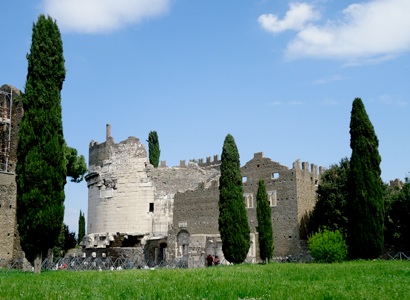
Photo: The Tomb of Cecilia Metella.
After lunch we hiked 3 kms down the road to the Villa of the Quintilii, a complex so large it was first imagined to be a town when it was first excavated. It was built by two wealthy brothers in the second century and coveted by the Emperor who killed the brothers and confiscated their property. The structures that stand above the terrain have, in their ruined state, a semiabstract quality. When viewed from a certain angle they appear to progressively reduce their complexity down to a single arch, which presents as a geometric symbol interfacing with the landscape and the sky with all the profundity of a span from Stonehenge.
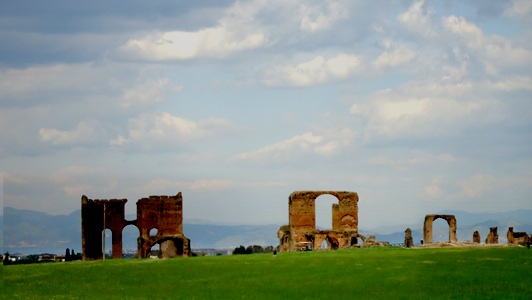
Photo: The Villa of the Quintilii.
The return journey down the Appian Way entered the Aurelian wall at Porta San Sebastian (St Sebastian Gate). This passage is replicated in the “Arch of Drusus” which is much older and stands immediately behind the gate. Its exact history is disputed however it once supported an aqueduct that supplied the baths of Caracalla.
This excursion has to rate as one of my most memorable days.
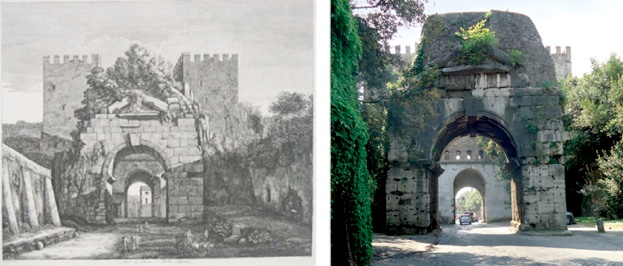
April 18
My first Italian lesson. I had to write down all the Italian words I could think of, and only got to 23. And that included “pizza”, “latte” and “cappuccino”!
April 19
The City of Rome study group was going to Trajan’s Market, arguably the world’s oldest purpose built shopping mall, so I tagged along. This multilevel structure built around the year 100, included shops, bars and administrative offices in its arcades. Trajan’s column stands in the northern corner of this forum with an inscription identifying it as marking the height of the hill Trajan removed to build it. This makes it a kind of memorial for the landscape, but it also became the mausoleum for the man himself. His feats in battle are recorded in a continuous scroll engraving around the outside through which his status is elevated above that of mere mortals, or at least to the height of the hill he removed.

Photo: Trajan’s Market, with Trajan’s column in the background (left).
Bumped into the AGNSW tour group on my return. They were sketching in the Borghese Gardens nearby. Christopher and Michelle enjoyed a boating interlude on the lake, and I made an ink wash drawing of the temple facade which I offered as a memento of their day.
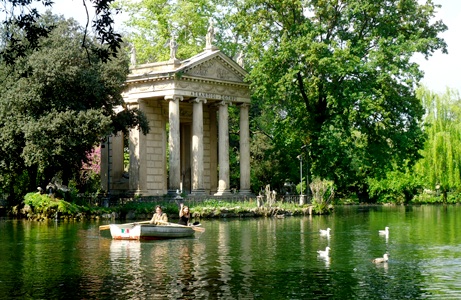
Photo: The Borghese Gardens.
A meeting of BSR artists agreed to a title for our end of term show: Fountains and Drains. This open metaphor relates nicely to my interest in the classical beauty to be found in urban infrastructure. Water plays an historical role in the city, via the Tiber, aqueducts, bath houses and the already named fountains and drains. The Art Director, Jacopo Benci, informed that it also relates to a popular vote against the privatisation of water that is current in Italy.
A classmate from NAS, who is on the AGNSW tour of Rome, joined me for dinner at the BSR.
April 20
Joined the BSR excursion down the Appian Way, which brought us back to the double gate I visited on Sunday. A museum within Saint Sebastian’s Gate provided some of the history behind the various phases of its construction, and a view into the luxury villas that have become foreign embassies below. We entered the grounds of one and visited two underground columbaria. Each contained the burnt remains of several hundred middle-class Romans who had paid an annual subscription to a funerary club to ensure their burial. One cannot help seeing the pack-n-stack logic of the insulae replicated in death.
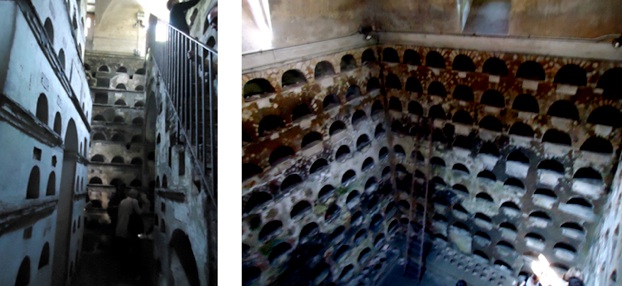
Photo: The Columbaria of the Vigna Codini - High-rise entombing.
The Columbarium of Pomponius Hylas is located in a public park nearby and contains more elaborate tombs, including a scaled down replica of a temple. The painted images identify it as a temple to Dionysus, the god of wine and revelry, who like Apollo, was the son of Zeus, although his personification of wild ecstasy contrasts with Apollo’s cool reason. He is presented with a bucket from which magic energy radiates with little lightning zaps. Ironically, a sign nearby warns of the radiation that comes from the tufa stone within the tomb.
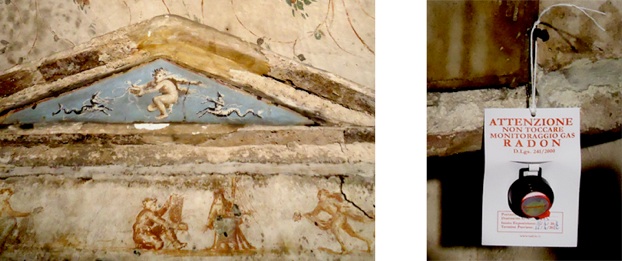
Photo: Getting zapped in the Columbarium of Pomponius Hylas.
We then walked down to the Baths of Caracalla - a humungous entertainment centre for the people of Rome, offering everything that was lacking in the high density insulae. It was built to a symmetrical plan, twinning everything on either side of a central axis. This would have served split sex bathing. However, the Farnese Hercules came from the baths and was paired with a second version and I am struck again by a recurring theme of duality.

Photo: The Baths of Caracalla.
I took my first journey on the Rome Metro and caught a hand in my pocket trying to relieve me of my wallet before the train doors had even closed! The clumsy pick-pocket was big enough to be intimidating and when I realised I was sandwiched against his partner I feared a more direct mugging. But I shouted, they backed off and I will now try to only carry loose change when I travel on public transport!
The Wed evening lecture examined the wall paintings from the House of Augustus. These provide illusionary architectural elements framing views through arches, complimented by simulated panel paintings. The case that was being made by the young American speaker, was that Augustus who had opposed private ostentation was staying true to his principles by merely simulating the paintings he believed belonged in the public realm.
I found the murals too involved to be convincing as a humble substitute for more direct paintings. The Roman use of veneer finishings and trompe l'oeil image would suggest a fascination with the idea of illusion that, like our fascination with virtual reality offered by CGI, is linked to creating realities of the mind. It seems no coincidence that this occurs within the manmade space of architecture.
The use of oblique angles and foreshortening would also indicate the ancients had a pretty good grasp on perspective, long before the Renaissance laid claim to this knowledge.
22 April
Off to Rome’s ancient seaport, Ostia, located 30 kms to the northeast, at the “mouth” of the Tiber from which it received its name, but where even the river and coast line it once stood against have moved away - due to silting.
The overcast conditions were not brilliant for taking photos, but it was fantastic walking through the remains of an entire ghost town that is several millenia old, and I had fun with the panoramic function on my digital camera.

Photo: View from the temple in the central forum.

Photo: At the theatre.

Photo: Inside a tavern.

Photo: Fresco remains from an insula in which illusionistic columns and framed designs repeat.

Photo: Bacchus with substitute head, next to the oldest synagogue in Europe. (Photo Daniel Wroe)
April 23
Ivan, a former classmate who was on the AGNSW tour stayed on for a days at the BSR as my guest. We went for a walk down to the Vatican. Being the day before Easter I expected a multitude, but there was plenty of room in the courtyard in front of St Peters. I was struck by the physical response to the architectural space that one can never get from looking at pictures, even if it’s hard to associate this grandeur with the simplicity of the Jesus from the Gospels.

I could not help associating the form of the colonnade, especially when viewed through the twin gate entrance, with the sweeping curve of a freeway overpass.

Photo: Entrance to to St Peters.
Took the long walk back. The crowds at the Pantheon were too much. In fact, the whole city was bursting with the Easter holiday crowd, who must have been taking in the sights of the city before the Easter mass at St Peters.
Stopped off at a church in the Piazza del Popolo (The Santa Maria del Popolo) where two masterpieces by Caravaggio, The Conversion of St Paul and The Crucifixion of St Peter, flank The Assumption of the Virgin Mary, by Annibale Carracci.
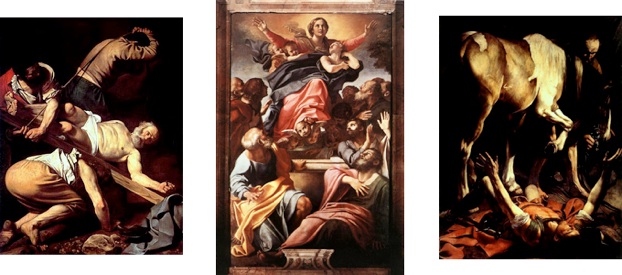
Photo: Paintings from the Cerasi Chapel in the church of Santa Maria del Popolo.
Carracci’s bright colours, glowing light, and idealised representations are very different to Caravaggio’s use of high contrast, both in the use of strong light and shadow (tenebrism) and in presenting the profound with the more ordinary or profane. In this case it seems posteriors (that of a man raising Peter’s cross and St Paul’s horse) are quite prominent.
24 April - Easter Sunday
A restaurant booking was made for Easter Sunday. We passed the Pyramid of Cestius on the way.

Photo: The Pyramid of Cestius. 18th century engraving by Giuseppe Vasi, and from the bus today.
Built as a tomb around 15 BC, Cestius had decreed in his will that his collection of tapestries should be buried with him. This was subsequently ruled as unlawful in the Augustan crack down against private excess.
Our restaurant was located in the ruins of a columbarium about two miles down the Appian Way, not far from the early Christian catacombs. A very pleasant afternoon was had in the rustic ambience of an ancient tomb - an appropriate venue, I thought, for our Easter excess!

Photo: Easter lunch with good company in an ancient columbarium (Hostaria Antica Roma).
Even the pot plants were growing in replica sarcophagi that Michelle, a Canadian scholar, identified, from relief engravings, as belonging to a child.
The four-course indulgence was followed by a leisurely 7 km walk back to the BSR.
27 April
It has been great having some familiar company, but Ivan’s visit came to an end. Rainy conditions had kept us indoors (mostly) for a couple of days. I got some painting done, while Ivan did some research in the library and went out to see the Colosseum.
After farewelling Ivan, I went to the University of Rome to see an exhibition by the art director from the BSR. I got the hours wrong and missed the show, however I enjoyed the architecture, built in the Neoclassical or ”rationalist” style under the fascist regime, where it seems the curve was banished by the more binary opposition of the vertical and horizontal.
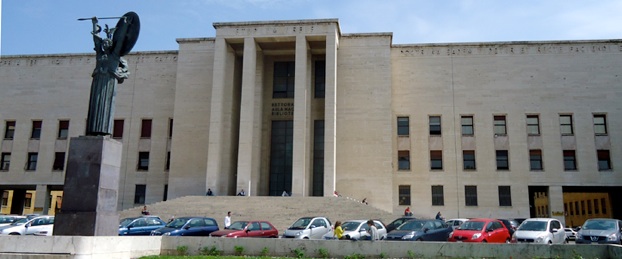
Photo: Sapienza University of Rome.
I had been painting with a limited pallet of crimson, warm yellow and green, and have noticed they are similar to the colours that commonly appear in ancient frescoes.
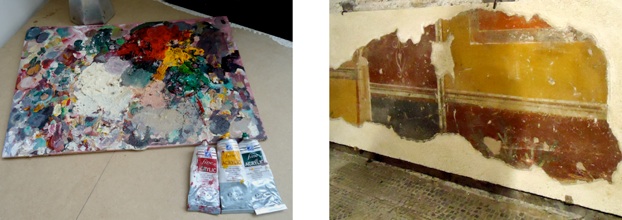
Photo: My reduced pallet and the remains of a fresco from Ostia.
I rearranged my studio and set up a shelf where I can work on several paintings at a time. I also put up pictures that Michelle Hiscock had provided of Roman landscape paintings done by master painters over the centuries. I am hoping this helps orientate my work as I stumble along in their footsteps.
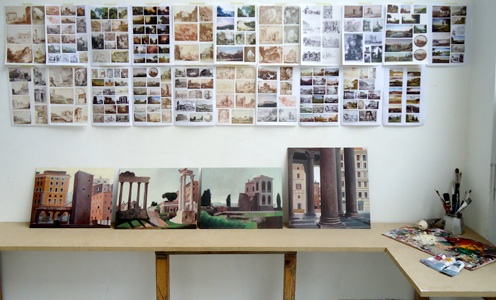
Photo: Making the most of Michelle Hiscock’s research.
28 April.
The Wednesday evening lecture was presented by Ellen Westcott, (from Macquarie Uni), on the sentiment expressed in tomb epitaphs. Today we went and saw the tombs she spoke about at Isola Sacra, located across the river from Ostia (northern side).
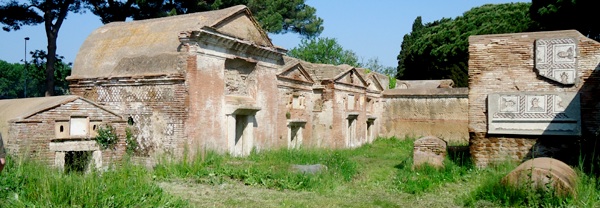
Photo: Isola Sacra, city of the dead.
We passed an excavation site where a Roman boat was being unearthed.
It made the headlines the next day.
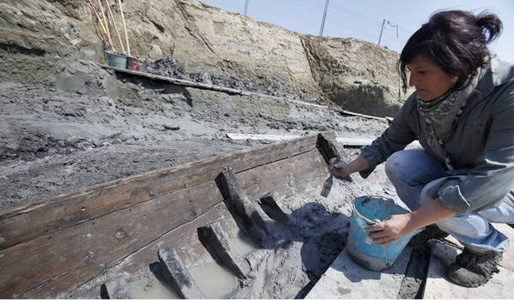
Photo and story: http://www.pasthorizons.com/index.php/archives/04/2011/imperial-period-roman-ship-found-in-ostia-antica
There were a couple of boats represented at Isola Sacra too. A mosaic depicting two boats and a lighthouse has a message in Latin which reads (approximately) “Here ends all care”. Dr Robert C-S said it reminds him of the final scene of the Johnny Depp film, Dead Man. The Sting song All this Time came to my mind.
(http://www.youtube.com/watch?v=4LdUme7QZLY)
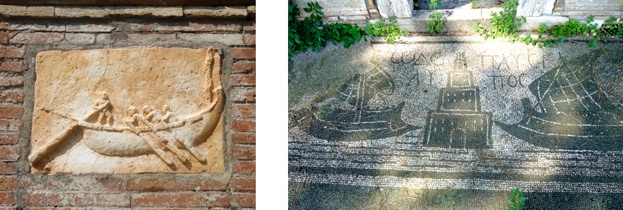
We also visited Portus, a manmade Roman sea port 4 km north of Ostia that included an artificial island, but due to the receding coastline is now reduced to an hexagonal lake.
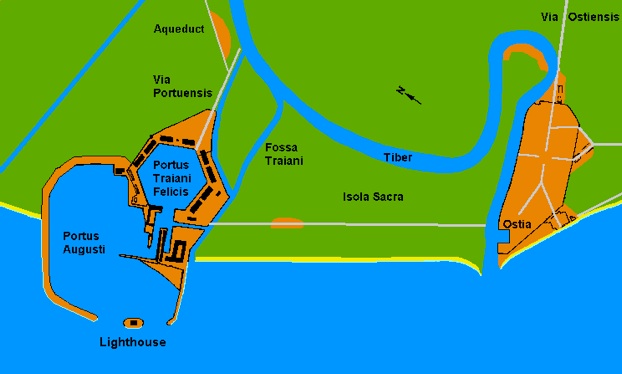
Photo: Map of Portus showing outer and inner harbour, and relationship to Isola Sacra and Ostia.
The BSR team are working on excavating a late antique bastion here and were in the process of exhuming a skeleton from a roadside tomb, that probably dates back to the sixth century. A police investigation seems unlikely.
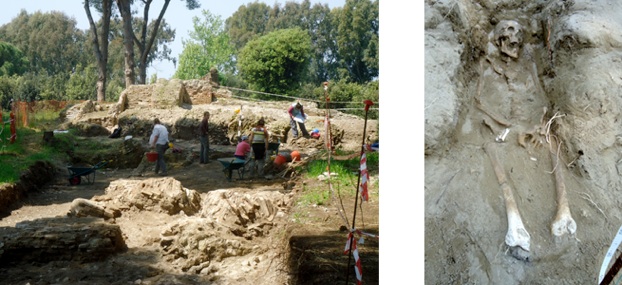
Photo: BSR excavation team at Portus unearths a 1400 year old corpse.
On the return journey, I managed to get a photo of an overpass and an aqueduct side by side through the bus window
